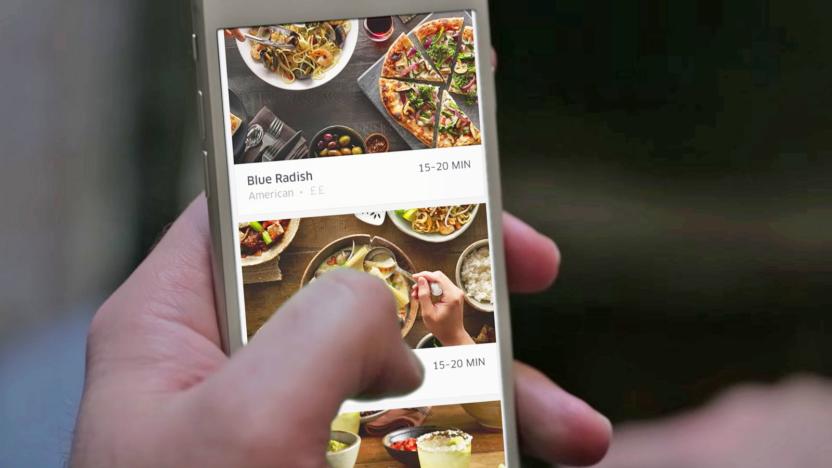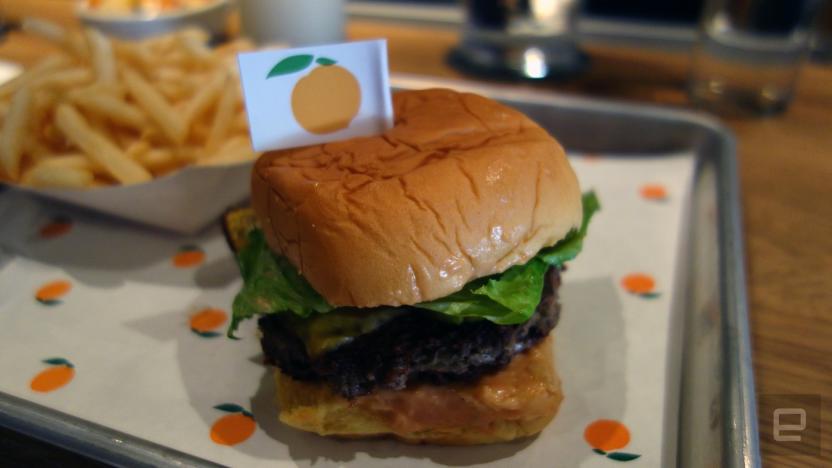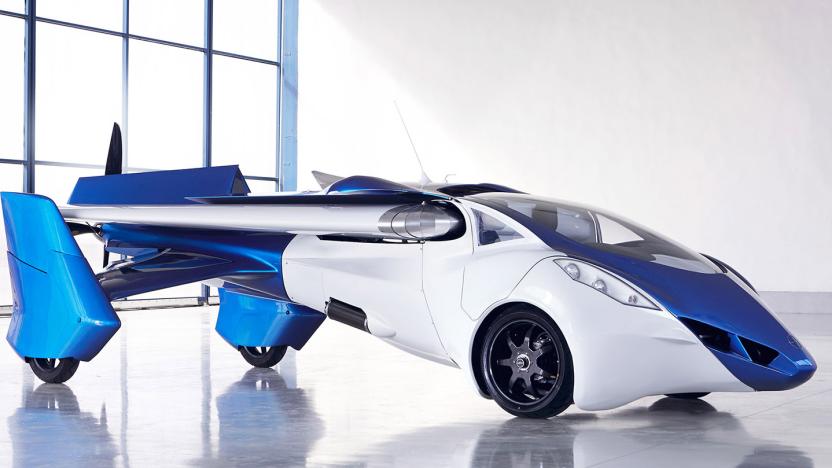foodanddrink
Latest

Google AI builds a better cucumber farm
Artificial intelligence technology doesn't just have to solve grand challenges. Sometimes, it can tackle decidedly everyday problems -- like, say, improving a cucumber farm. Makoto Koike has built a cucumber sorter that uses Google's TensorFlow machine learning technology to save his farmer parents a lot of work. The system uses a camera-equipped Raspberry Pi 3 to snap photos of the veggies and send the shots to a small TensorFlow neural network, where they're identified as cucumbers. After that, it sends images to a larger network on a Linux server to classify the cucumbers by attributes like color, shape and size. An Arduino Micro uses that info to control the actual sorting, while a Windows PC trains the neural network with images.

Bosch and Drop team up on smarter kitchen tech
Many appliance makers are forming partnerships to drag their lineups into the smart home era, but Bosch's alliance may be something special. It's teaming up with Drop (of smart scale fame) to add intelligence to kitchen devices. The two are starting modestly: if you have a Series 8 oven with Home Connect support, you can already use Drop to control the appliance as well as monitor the temperature and time. However, the companies have grander things in store.

MIT gives pesticides an electric charge to improve stickiness
There are plenty of problems with pesticides -- making bees dumb, anyone? -- but the biggest is probably how much is wasted while it's being sprayed onto crops. Because of how certain leaves naturally repel water, it means that hardly any anti-bug treatments actually, you know, stick to them. In fact, only two percent of the spray stays in place, according to MIT News. So, to change that, a team of researchers have devised a way to increase the amount of liquid a leaf's surface retains.

UberEats drivers are revolting in London
Established food delivery service Deliveroo and recently launched UberEats might be competitors in the UK, but their drivers have found a common enemy in the businesses they work for. UberEats couriers have planned a protest outside Uber's London HQ today, over changes to their pay structure they say could lead to them earning less than the minimum wage, The Guardian reports.

ICYMI: The USDA created milk-based cling wrap
try{document.getElementById("aol-cms-player-1").style.display="none";}catch(e){}Today on In Case You Missed It: MIT's Self Assembly Lab came up with a phone that can be put in something that looks like your old rock tumbler and snap together by itself, with the force of magnets. And scientists at the US Department of Agriculture created food packaging clingwrap made of milk protein that's both biodegradable and edible. We wanted you to see the bagpiping Charmander and also the Indiegogo project with a tiny bear. As always, please share any interesting tech or science videos you find by using the #ICYMI hashtag on Twitter for @mskerryd.

Edible milk-based film preserves food better than plastic
Figuring out how to keep food fresh was a challenge seemingly met by plastics. But as it became clear that spooling out all that synthetic packaging was adversely affecting the environment, interest in greener methods of preservation has spiked. While most containers in your grocery store can be recycled, the thin film stretched over fresh-cut meat can't be — and it's not even that good at keeping food unspoiled. Now, US Department of Agriculture researchers have pioneered a drastically more efficient covering...and it's made out of milk.

Joule proves sous vide cooking doesn't have to be intimidating
Despite the recent rise of affordable sous vide machines, the cooking concept has always skewed a little nerdy. Preparing food in vacuum-sealed bags in a temperature-controlled water bath sounds like something only culinary geeks would do, even if it results in perfectly cooked meats. By and large, these devices look and feel like scientific equipment: They're bulky with large dials. They look like they belong in a lab, not a kitchen.

ICYMI: Goat-inspired robot design and apple picking
try{document.getElementById("aol-cms-player-1").style.display="none";}catch(e){}Today on In Case You Missed It: A researcher at Carnegie Mellon created the GOAT leg for robots that moves much like a pogo-stick and posted a video of its tests to YouTube. Meanwhile a robot to harvest apples might still be in prototype, but it's miles more advanced than the thing that just shakes trees violently until all the apples fall off. The mechanized sushi chef video can be found here, the boy who swallowed a dog toy here, and Joe Biden not being able to let go is here. As always, please share any interesting tech or science videos you find by using the #ICYMI hashtag on Twitter for @mskerryd.

The Impossible Burger is a lab-made meatless treat for carnivores
Every October, two vegetarian friends of mine from Michigan spend a week at my place while they attend New York Comic Con. Because I take my hosting duties very seriously, I always try to find good places for them to eat here in New York. It's not too hard, as you can find vegetarian and vegan restaurants for pretty much every major cuisine here. But one thing that I haven't been able to locate is a good meat substitute. That changed last week when a restaurant here in the city became the first and (so far) only location to offer the Impossible Burger, a lab-developed patty that claims to replicate the taste and texture of real beef using the similar proteins found in plants. I dropped by for lunch to test this assertion -- and to scope it out for my friends, of course.

Solar-powered machine turns urine into drinkable water
Scientists from a Belgian university have built a solar-powered machine that can turn urine into drinkable water. They deployed it at a 10-day music and theater festival in central Ghent, Belgium. The experiment was a success as the scientists were able to recover a 1,000 litres of unconsumed water, which will be used to make Belgian beer, from the urine of several partygoers.

Zagat's new iPhone app is like the best of Yelp and Foursquare
After buying the restaurant review company Zagat back in 2011, Google helped to modernize it with a new website, mobile apps and integration within Google Maps. Today, Zagat is getting its biggest upgrade yet on the iPhone, and it's good enough to make it your primary solution for discovering new places to eat. The app is now smart enough to recommend restaurants based on your location, as well as the time of day. That location awareness is a big part of what makes Foursquare's recommendations useful, and it's nice to see it finally show up in Zagat (albeit surprisingly late).

Six vehicles powered by coffee, saltwater, sewage and other crazy fuels
By Cat DiStasio When it comes to advances in automotive technology, the search for alternative fuels is pretty exciting. Of course, you've heard about biodiesel engines converted to run on used vegetable oil that sputter out little more than water and the faint smell of French fries. However, there's a slew of vehicles out there that run on all sorts of other fuels too. There's an electric car powered by caffeine, as well as a hot rod that runs on air. Other curious fuel sources include plain old saltwater, crude made from algae, and (inevitably) there are even a number of vehicles designed to run on biogas generated from livestock waste (or, in layman's terms, cars that run on poop). Although some may be smellier than others, these inventive energy sources offer an intriguing alternative to conventional fossil fuels.

'Pokemon Go' launches in Japan under golden arches
Despite being the true home of Pocket Monsters, until today, Japanese fans weren't able to download the smartphone phenomenon that is Pokemon Go. As rumored, Niantic Labs' game launches in Pikachu's homeland with a promotional tie-in with McDonald's (it's already offering Pokemon toys with its kids' meals in anticipation) and the app maker says more sponsored locales and events are on their way. Ingress, the location-based game that preceded Pokemon Go, ran multiple promotions with companies including McDonald's and SoftBank in Japan -- as well as Jamba Juice in the US. Expect see plenty more sponsored locations in Pokemon Go (well, gotta make some money when the app is free to download), but what exactly do the sponsored locations entail? The good news is that the tie-in doesn't seem to change much at all -- and could even be good news for some players.

A month without bacon because my genes said so
If you've ever stumbled across the more inspirational corner of Instagram, you'll find plenty of images pertaining to motivation. After all, few of us are physically incapable of at least trying to be athletic, but not everyone will haul enough ass to actually make it happen. I've made a career of using technology to lose weight, although never quite reaching my target. I put that down to a crippling lack of motivation, but for the first time in my adult life, I've spent the past three weeks eating salads as a component of every meal. Why? Because I'd rather not get Parkinson's, Alzheimer's or cancer if I can avoid it.

Inhabitat's Week in Green: Flying cars and an urban underground park
The Tesla Model X is the best car in its class - but it's also prohibitively expensive with a MSRP of $83,000. That's set to change, as Tesla just launched a new version of its electric SUV that is $9,000 cheaper. If you're holding out for a flying car, you won't have to wait much longer - Aeromobile just unveiled a brand new prototype and announced plans to launch a commercial flying vehicle by 2017. The European Space Agency backed a new hypersonic plane that will be able to travel from London to Sydney in four hours flat. And a Welsh company created a truck that carries its own road surface, lays it down, and then picks it back up.

Cooking in the great outdoors
Camping is a wonderful way to get away from the hustle and bustle of the overly stimulating modern world. If you're fortunate, you'll venture beyond cell coverage for a distraction-free trip into the wild. It's wonderful... until you realize you can't get a pizza delivered.

AI is being used to brew beer in the UK
Brewers have a lot of tools at their disposal when it comes to brewing beer: hops, yeast, grain and loads of equipment. One brewery in the UK is employing AI to perfect its recipes though, and it claims it's the first to do so. IntelligentX Brewing Company is a collaborative effort between machine learning company Intelligent Layer and creative agency 10x. Together the two companies created algorithms that process consumer feedback as a means of helping brewers improve their beers.

This tiny contraption is capable of producing endless wine
When you're down to the last glass of wine from the bottle you could have just sworn was full before, you could really use this contraption one Iowa State University professor is developing. It's a tiny device that's capable of creating a continuous supply of fresh wine. Yeah, you read that right.

Spongy electronic 'nose' can sniff out nerve gas and pesticides
When you're trying to detect extremely dangerous chemicals, you don't want to mess around -- even a tiny amount can spell big trouble. It's a good thing, then, that Belgian researchers have developed what could be the most sensitive gas sensor to date. Their electronic 'nose' uses spongy metal-organic frameworks (below) that can absorb and flag extremely tiny amounts of the phosphonates you find in harmful gases like sarin (aka a form of nerve gas) or pesticides. It's so sensitive that, in some cases, it can find just a few parts per trillion -- even the cleverest evildoer would likely have trouble hiding a chemical weapon.

Six technologies changing the future of food
By Cat DiStasio Food production, processing and transportation account for a tremendous amount of greenhouse gas emissions, and enormous amounts of food are wasted each year in some parts of the world while other regions suffer from shortages. Fortunately, agricultural engineers and scientists are working hard to increase food production, create cleaner agricultural processes and develop greener packaging. With technological advancements, it may be possible to sharply reduce carbon emissions from the agriculture and food industries while simultaneously addressing food supply issues.














